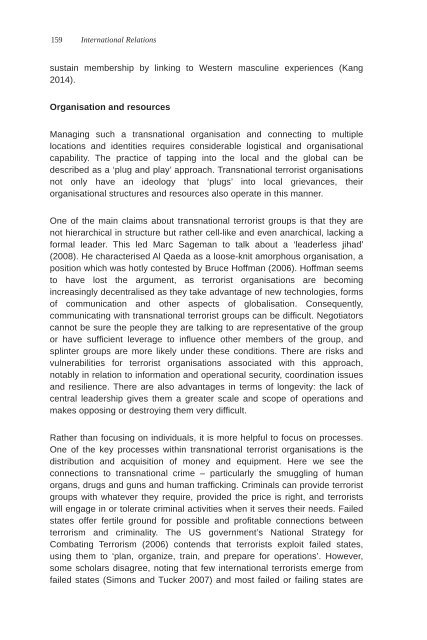International Relations
International-Relations-E-IR
International-Relations-E-IR
You also want an ePaper? Increase the reach of your titles
YUMPU automatically turns print PDFs into web optimized ePapers that Google loves.
159 <strong>International</strong> <strong>Relations</strong><br />
sustain membership by linking to Western masculine experiences (Kang<br />
2014).<br />
Organisation and resources<br />
Managing such a transnational organisation and connecting to multiple<br />
locations and identities requires considerable logistical and organisational<br />
capability. The practice of tapping into the local and the global can be<br />
described as a ‘plug and play’ approach. Transnational terrorist organisations<br />
not only have an ideology that ‘plugs’ into local grievances, their<br />
organisational structures and resources also operate in this manner.<br />
One of the main claims about transnational terrorist groups is that they are<br />
not hierarchical in structure but rather cell-like and even anarchical, lacking a<br />
formal leader. This led Marc Sageman to talk about a ‘leaderless jihad’<br />
(2008). He characterised Al Qaeda as a loose-knit amorphous organisation, a<br />
position which was hotly contested by Bruce Hoffman (2006). Hoffman seems<br />
to have lost the argument, as terrorist organisations are becoming<br />
increasingly decentralised as they take advantage of new technologies, forms<br />
of communication and other aspects of globalisation. Consequently,<br />
communicating with transnational terrorist groups can be difficult. Negotiators<br />
cannot be sure the people they are talking to are representative of the group<br />
or have sufficient leverage to influence other members of the group, and<br />
splinter groups are more likely under these conditions. There are risks and<br />
vulnerabilities for terrorist organisations associated with this approach,<br />
notably in relation to information and operational security, coordination issues<br />
and resilience. There are also advantages in terms of longevity: the lack of<br />
central leadership gives them a greater scale and scope of operations and<br />
makes opposing or destroying them very difficult.<br />
Rather than focusing on individuals, it is more helpful to focus on processes.<br />
One of the key processes within transnational terrorist organisations is the<br />
distribution and acquisition of money and equipment. Here we see the<br />
connections to transnational crime – particularly the smuggling of human<br />
organs, drugs and guns and human trafficking. Criminals can provide terrorist<br />
groups with whatever they require, provided the price is right, and terrorists<br />
will engage in or tolerate criminal activities when it serves their needs. Failed<br />
states offer fertile ground for possible and profitable connections between<br />
terrorism and criminality. The US government’s National Strategy for<br />
Combating Terrorism (2006) contends that terrorists exploit failed states,<br />
using them to ‘plan, organize, train, and prepare for operations’. However,<br />
some scholars disagree, noting that few international terrorists emerge from<br />
failed states (Simons and Tucker 2007) and most failed or failing states are


